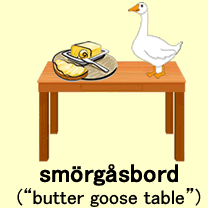
One of the Dutch words I learnt this week is boterham [ˈboːtərˌɦɑm], which means sandwich. The boter part means butter, but it’s not certain where the ham part comes from – possibly *ramme / remme (thick slice of bread), or from ham (chunk). Or it might be an abbreviation of boterenbroot (buttered bread) [source].
In Swedish one word for sandwich is smörgås, from smör (butter) and gås (goose). It originally referred to small pieces of butter which float to the surface of the milk as it is churned, and which were spread on bread, and came to mean bread, butter plus toppings, or an open sandwich [source].
A smörgåsbord [ˈsmœrɡɔsˌbuːrd] (“butter-goose-table”) is a buffet made up of many cold dishes, and the slices of meat, cheese and other toppings on the smörgåsar are known as smörgåspålägg.
Other Swedish words for sandwich include macka (open sandwich), sandvikare (sandwich), snitt (dainty sandwich, cut, fashion) and sandwich.
The sandwich is named after the 4th Earl of Sandwich, John Montagu, who is reputed to have invented it as a convenient way to eat while playing cards. He didn’t come up with the idea of putting meat or filling between two slices of bread, but he certainly popularised it and gave it his title [source].
Sandwiches are also known as sarnies, sangers or butties, at least in the UK. Are there other words for them in other English-speaking places?
Are there interesting words for sandwiches in other languages?
Lots of languages have taken sandwich in as a loanword.
In Finnish an (open) sandwich is voileipä (‘butter(ed) bread’). Finnish hasn’t borrowed the word sandwich, and I guess we use the same word of a layered sandwich as well. Wikipedia mentions the words kerrosvoileipä (‘layered butter bread’) and täytevoileipä (‘filled butter bread’). A roll with fillings we just call sämpylä (‘roll’). There’s also kolmioleipä (‘triangle bread’) which means a triangle sandwich.
My thought was not so much about sandwiches but about bread. I remember a story once discussing the history of bread, and the point was that there is no record of any society throughout history that did not have some form of grain that was ground, flattened and cooked. Besides common slices of bread, there are pancakes, waffles, crepes, tortillas, egg rolls, pasta (a grain-food which is boiled instead of baked) etc. etc. It seems combining a flattened-grain food with a filling was just a matter of time. Bread (with all its variant forms) seems to speak to an innate human need. Perhaps it’s the world’s oldest “comfort food”, which is why there are so many interesting words for it in so many languages.
As far as I know sandiwch in Spanish is emparedado, which means “to be walled”, a type of emparedado is bocadillo or bocata, which is made of bread broken in half and it means “bite”. In Catalan is entrepà, which means “between bread”. And in Mandarin Chinese is 三明治 (sānmíngzhì), which means “three rules”.
I didn’t know what smorgasbord meant in English, so thanks for that. What I find interesting is that in Russian, smorgasbord is Шведский стол/Swedish table. No mention of a sandwich, but definitively a table full of cold meats, cheeses and veggies!
I think there is no word for the sandwich in Hindi, Urdu, or any of the Indian languages. The closest food we have with filling inside is a Puri but it is filled inside a flatbread called Puri.
Peter Fustumum! Sanmingzhi is meant to sound like ”sandwich”!